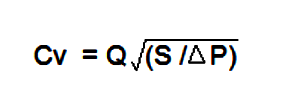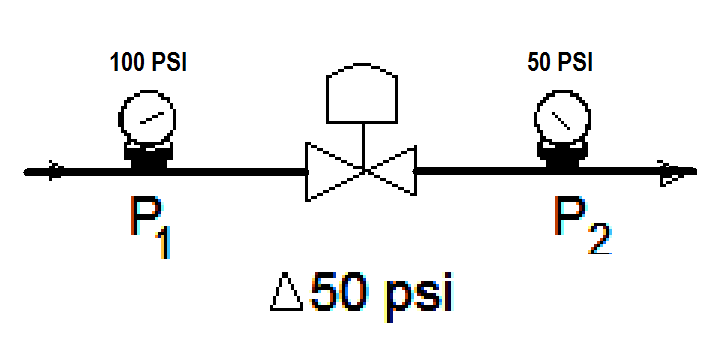The relationship between pressure drop and flow rate through a valve is conveniently expressed by a flow coefficient (Cv).
Control Valve Capacity - Cv: For sizing a control valve we are interested in knowing how much flow we can get through the valve for any given opening of the valve and for any given pressure differential.
What is Flow Coefficient (Cv)?
Flow coefficient (Cv) is defined as the number of gallons per minute (gpm) at 60°F that will pass through a full open valve with a pressure drop of 1 psi.
Simply stated, a control valve which has a Cv of 12 has an effective port area in the full open position such that it passes 12gpm of water with 1 psi pressure drop.
The Cv for water is usually determined experimentally by measuring the flow through a valve with 1 psi applied pressure to the valve inlet and have a 0 psi pressure at the outlet.
For incompressible fluids like water, a close approximation can be found mathematically by the following equation;

Where,
• Cv = Valve flow coefficient
• Q = Fluid flow, US GPM (also given by Area of pipe x mean velocity)
• S = Specific gravity of fluid relative to water @ 60ºF
• ∆P = Pressure drop (P1 – P2) across the control valve at maximum flow, psi
The equation shows that the flow rate varies as the square root of the differential pressure across the control valve. Greater the pressure drop, higher will be the flow rate.
Pressure drop across a valve is highly influenced by the area, shape, path and roughness of the valve.
Example:
Assume there is a 15 psi pressure drop across a control valve when the valve is wide open with a flow rate of 150 gpm of water through the valve. The specific gravity of water is one. The valve coefficient can be calculated as:

Once we know the valve coefficient, we can then calculate the pressure drop across the valve for a given flow rate, OR a flow rate for a given pressure drop. For example, determine the pressure drop across the above valve if the flow rate increases to 200 gpm.

In practice, once you know the design flow rate and the desired pressure drop, one can calculate the required valve Cv and select a proper valve from the manufacturers’ literature.
Note:
The Kv value is the metric equivalent of Cv expressed in m3 /hr with 1 bar pressure drop at a temperature between 5 °C and 40 °C. Cv = 1.15 x Kv).
